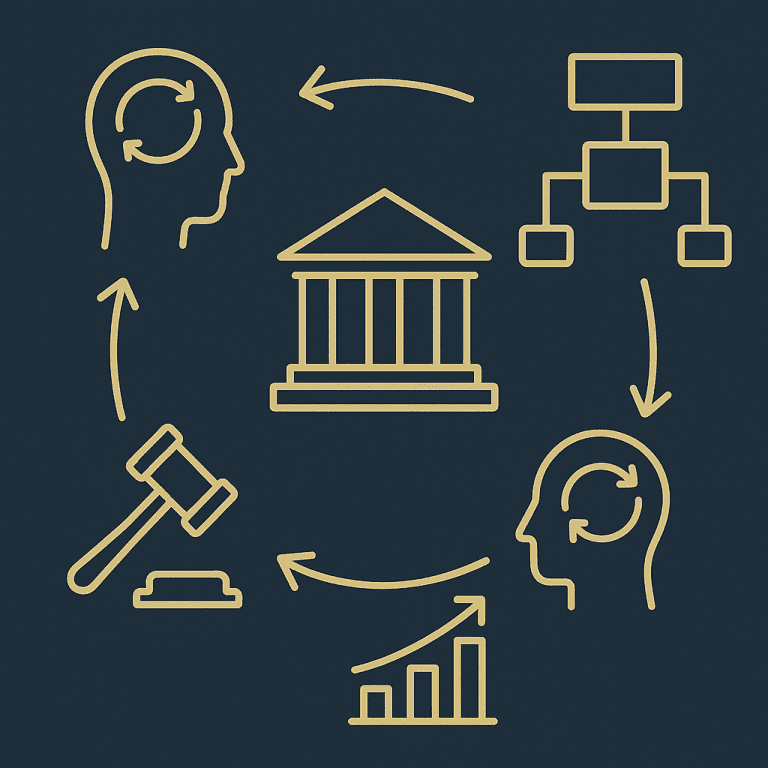When Machines Meet Complexity: Designing for the Real World
Technology thrives on logic, precision, and elegant optimization. But the real world — the dynamic, unpredictable environment where technology must actually operate — is anything but linear.
From sprawling software systems and critical infrastructure to evolving cybersecurity threats and learning algorithms, today’s engineered solutions don’t live in sterile labs. They live in messy, fluid contexts shaped by human behavior, legacy constraints, market volatility, and natural unpredictability.
So what happens when tightly written, logically coherent code meets a loosely wired, rapidly changing world?
That’s precisely where systems thinking steps in — not as a substitute for deep technical skill, but as its most powerful complement. It equips engineers, developers, and technologists to move beyond perfect parts to embrace and design for the imperfect whole. It helps them ask not just “Does this component work?” but more critically, “How does the entire system behave in the wild?”
In this post, we explore four domains where systems thinking dramatically enhances engineering and tech design — enabling adaptability, resilience, and innovation in the face of real-world complexity.
🧩 1. Systems Engineering
From isolated components to integrated, evolving purpose
Traditional systems engineering thrives on structure: detailed specs, modular design, rigorous testing. But in complex environments, even perfectly built parts can generate surprising — even dangerous — behavior when stitched together.
Systemic Insight:
- The system is more than the sum of its parts. New dynamics often emerge only during integration — invisible in isolated unit tests.
- Linear architectures can hide nonlinear ripple effects. A minor change in one module can unexpectedly amplify or destabilize the entire system.
- Stakeholders shape systems. Designs that ignore user behavior, maintenance realities, or organizational friction often fail in implementation — despite technical brilliance.
Example:
An autonomous vehicle system passes all individual component tests. But in urban deployment, subtle edge-case interactions — unpredictable pedestrians, sensor glare, extreme weather — expose systemic fragilities no lab test could catch.
Action Points:
☑ During early design, map feedback loops across both technical and human interactions.
☑ Account for delayed effects like user workarounds or maintenance degradation.
☑ Test under real-world uncertainty, not just controlled environments.
🧠 2. Complex Adaptive Systems (CAS)
From rigid control to designing with emergence
Many modern systems — from social platforms and autonomous drones to IoT networks and ML models — behave more like living systems than machines. They adapt, evolve, and interact unpredictably. Attempts to fully control them linearly often backfire.
Systemic Insight:
- CAS are not “solved” — they’re co-evolved with. Effective systems learn and adapt continuously.
- Behavior emerges from interaction, not instruction. It’s not just the parts — it’s the dance between them.
- Small changes can cascade. Reinforcing loops mean minor shifts can trigger exponential effects.
Example:
A social media recommendation algorithm unintentionally creates echo chambers and polarizes users — not due to flawed code, but because engagement loops amplified behavior over time, in response to the algorithm’s own influence.
Action Points:
☑ Model behavior over time, not just structure.
☑ Observe emergent loops in user feedback, automation, or markets.
☑ Apply CAS principles: build in slack, monitor tipping points, and design for learning.
🔐 3. Cybersecurity
From static defense to adaptive system vigilance
Cybersecurity is often framed as patching vulnerabilities and guarding perimeters. But real-world threats are adaptive, distributed, and systemic. Attackers evolve. Systems mutate. And defenses can have unintended consequences.
Systemic Insight:
- Attack surfaces are emergent. New dependencies, user shortcuts, and rapid updates constantly create novel entry points.
- Defensive controls create feedback. Too much friction can lead users to bypass systems, increasing risk.
- Threats are part of the system. Security must evolve in tandem, not just react to known exploits.
Example:
A bank’s strict 2FA slows fraud but leads users to write down credentials or use less secure apps. The system becomes more vulnerable, not less — a classic security backfire loop.
Action Points:
☑ Map security as a human-machine-behavior system, not just endpoints.
☑ Identify where controls create risky workarounds.
☑ Look for feedback loops: convenience → bypass → exposure → breach.
💻 4. Holistic Software Design
From clean code to contextual coherence
Software is never just code. It exists inside cultural norms, organizational processes, emotions, and habits. A feature’s impact isn’t just what it does — it’s what it sets in motion.
Systemic Insight:
- Features trigger feedback. What you build shapes behavior, which reshapes the system.
- Defaults define norms. What’s easiest becomes standard, even if suboptimal.
- Technical debt is a loop. Shortcuts today create inertia tomorrow.
Example:
An “auto-reply” feature adds convenience. But in high-volume teams, it floods inboxes, creates noise, and undermines communication — unintended but systemic effects.
Action Points:
☑ Map user behavior as feedback loops, not just journeys.
☑ Ask: What loops are we reinforcing? What might we break?
☑ Embed systemic questions into agile and design rituals.
🧪 Mini-Practice: Test for Nonlinear Cause & Effect
Pick a recent or current tech project — software, hardware, systems.
Now ask:
- Where did outcomes deviate from expectations?
- Where did small changes cause outsized effects?
- Where did fixing one issue create a new one?
Sketch it:
- Any reinforcing loops (e.g., success → more use → overload → failure)?
- Any balancing loops (e.g., alerts → fatigue → missed threats → breach)?
A quick causal loop diagram might reveal more than weeks of debugging.
🧠 Final Thought
Engineering isn’t just about parts. It’s about the whole.
The messy, evolving, unpredictable, human world into which your solution is released — that is your system.
Systems thinking doesn’t replace precision. It reveals context.
It doesn’t simplify complexity. It teaches you how to navigate it.
It shows where logic must meet humility,
where design must meet behavior,
and where code must meet consequence.
Because when machines meet complexity, the best engineers don’t just optimize…
They think in loops.
They design for emergence.
They build systems that thrive in the real world.
- The Whisper of the Whole: A Systems Thinking Guide for Consultants
- What is a System, Really?
- The Living Dance of Systems
- Resilience and the Wisdom of Adaptive Systems
- Roots of Insight
- The Systems Thinker’s Compass
- Drawing Complexity
- Peering Below the Surface
- Master Methodologies in Systems Thinking
- Enhancing Familiar Tools with Systems Thinking
- Transforming Business Through Systems Thinking
- Systems Thinking in Public Policy & Governance
- Sustainable Systems
- Systems Thinking for Engineering & Technology
- The Inner System: You
- The Roadblocks
- The Future of Systems Thinking
- Systems Thinking FAQ: Myths, Misunderstandings & Core Insights







